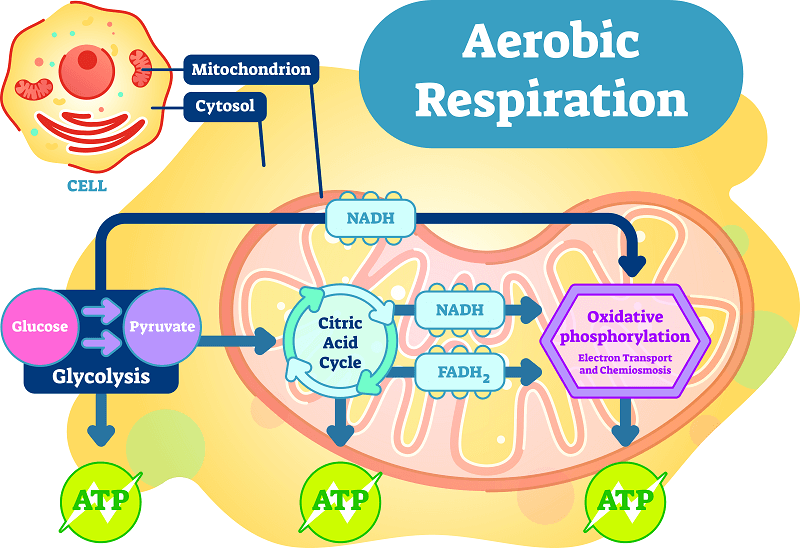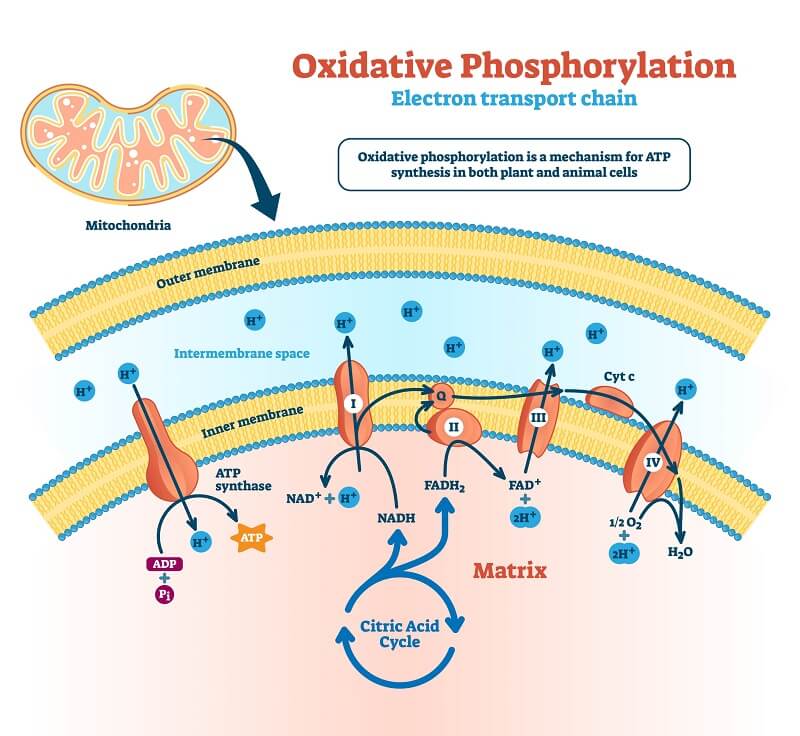Definition
Aerobic respiration is the process by which organisms use oxygen to turn fuel, such as fats and sugars, into chemical energy. In contrast, anaerobic respiration does not use oxygen.
Respiration is used by all cells to turn fuel into energy that can be used to power cellular processes. The product of respiration is a molecule called adenosine triphosphate (ATP), which uses the energy stored in its phosphate bonds to power chemical reactions. It is often referred to as the “currency” of the cell.
Aerobic respiration is much more efficient, and produces ATP much more quickly, than anaerobic respiration. This is because oxygen is an excellent electron acceptor for the chemical reactions involved in generating ATP.

Aerobic vs Anaerobic
Similarities
Both aerobic and anaerobic respiration are methods of generating energy. They also both start in the same way, with the process of glycolysis. “Glycolysis” literally means “sugar splitting,” and involves breaking a sugar molecule down into two smaller molecules.
In the process of glycolysis, two ATP molecules are consumed and four are produced. This results in a net gain of two ATP molecules produced for every sugar molecule broken down through glycolysis. This is where the similarities between aerobic and anaerobic respiration end.
In cells that have oxygen and aerobic respiration can proceed, a sugar molecule is broken down into two molecules of pyruvate. In cells that do not have oxygen, the sugar molecule is broken down into other forms, such as lactate.
Differences
After glycolysis, different respiration chemistries can take a few different paths:
- Cells using aerobic respiration continue their electron transfer chain in a highly efficient process that ends up yielding 38 molecules of ATP from every sugar molecule.
- Cells that are deprived of oxygen but do not normally use anaerobic respiration, like our own muscle cells, may leave the end products of glycolysis sitting around, obtaining only two ATP per sugar molecule they split. This is an inefficient method of obtaining energy by respiration.
- Cells that are made for anaerobic respiration, such as many types of bacteria, may continue the electron transfer chain to extract more energy from the end products of glycolysis.
After glycolysis, cells that do not use oxygen for respiration, but proceed to an electron transport train may use a different electron acceptor, such as sulfate or nitrate, to drive their reaction forward.
These processes represent a type of anaerobic respiration called “fermentation.” Some types of fermentation reactions produce alcohol and carbon dioxide. This is how alcoholic drinks and bread are made.
Aerobic respiration, on the other hand, sends the pyruvate leftover from glycolysis down a very different chemical path, the steps of which are discussed in detail below.
Steps of Aerobic Respiration
Overall Equation
The equation for aerobic respiration describes the reactants and products of all of its steps, including glycolysis. That equation is:
1 glucose + 6 O2 → 6 CO2+ 6 H2O + 38 ATP
In summary, 1 molecule of six-carbon glucose and 6 molecules of oxygen are converted into 6 molecules of carbon dioxide, 6 molecules of water, and 38 molecules of ATP. The reactions of aerobic respiration can be broken down into four stages, described below.
Glycolysis
Glycolysis is the first stage of aerobic respiration and occurs in the cytoplasm of the cell. It involves the splitting of 1 six-carbon sugar molecule into 2 three-carbon pyruvate molecules. This process creates two ATP molecules.
The overall equation is as follows:
C6H12O6 + 2 ADP + 2 PI + 2 NAD+ → 2 Pyruvate + 2 ATP + 2 NADH + 2 H+ + 2 H2O
This process reduces the co-factor NAD+ to NADH. This is important, as later in the process of cellular respiration, NADH will power the formation of much more ATP through the mitochondria’s electron transport chain.
In the next stage, pyruvate is processed to turn it into fuel for the citric acid cycle, using the process of oxidative decarboxylation.
Oxidative decarboxylation of pyruvate
2 (Pyruvate– + Coenzyme A + NAD+ → Acetyl CoA + CO2 + NADH)
Oxidative decarboxylation, sometimes referred to as the link reaction or the transition reaction, is the link between glycolysis and the citric acid cycle. Pyruvate is transfered into the mitochondrial matrix via a protein known as pyruvate translocase. Here, the pyruvate is combined with Coenzyme A to release a carbon dioxide molecule and form acetyl-CoA.
This transition reaction is important because acetyl-CoA is an ideal fuel for the citric acid cycle, which can in turn power the process of oxidative phosphorylation in the mitochondria, which produces huge amounts of ATP.
More NADH is also created in this reaction. This means more fuel to create more ATP later in the process of cellular respiration.
Citric Acid Cycle

The citric acid cycle, also called the tricarboxylic acid cycle or the Krebs cycle, is a series of redox reactions that begins with Acetyl CoA. These reactions take place in the matrix of the mitochondria of eukaryotic cells. In prokaryotic cells, it takes place in the cytoplasm. The overall reaction is as follows:
2 (ACETYL COA + 3 NAD+ + FAD + ADP + PI → CO2 + 3 NADH + FADH2 + ATP + H+ + COENZYME A)
The reaction occurs twice for each molecule of glucose, as there are two pyruvates and hence two molecules of Acetyl CoA generated to enter the citric acid cycle.
Both NADH and FADH2 – another carrier of electrons for the electron transport chain – are created. All the NADH and FADH2 created in the preceding steps now come into play in the process of oxidative phosphorylation.
In summary, for each round of the cycle, two carbons enter the reaction in the form of Acetyl CoA. These produce two molecules of carbon dioxide. The reactions generate three molecules of NADH and one molecule of FADH. One molecule of ATP is produced.
Oxidative phosphorylation
Oxidative phosphorylation is the primary energy providing stage of aerobic respiration. It uses the folded membranes within the cell’s mitochondria to produce huge amounts of ATP.
34 (ADP + PI+ NADH + 1/2 O2 + 2H+ → ATP + NAD+ + 2 H2O)
In this process, NADH and FADH2 donate the electrons they obtained from glucose during the previous steps of cellular respiration to the electron transport chain in the mitochondria’s membrane.
The electron transport chain consists of a number of protein complexes that are embedded in the mitochondrial membrane, including complex I, Q, complex III, cytochrome C, and complex IV.
All of these ultimately serve to pass electrons from higher to lower energy levels, harvesting the energy released in the process. This energy is used to power proton pumps, which power ATP formation.
Just like the sodium-potassium pump of the cell membrane, the proton pumps of the mitochondrial membrane are used to generate a concentration gradient which can be used to power other processes.
The protons that are transported across the membrane using the energy harvested from NADH and FADH2 “want” to pass through channel proteins from their area of high concentration to their area of low concentration.
Specifically, the channel proteins are ATP syntheses, which are enzymes that make ATP. When protons pass through ATP synthase, they drive the formation of ATP.
This process is why mitochondria are referred to as “the powerhouses of the cell.” The mitochondria’s electron transport chain makes nearly 90% of all the ATP produced by the cell from breaking down food.
This is also the step that requires oxygen. Without oxygen molecules to accept the depleted electrons at the end of the electron transport chain, the electrons would back up, and the process of ATP creation would not be able to continue.

Aerobic Respiration and Weight Loss
Aerobic respiration is the process by which many cells, including our own, produce energy using food and oxygen. It also gives rise to carbon dioxide, which our bodies must then get rid of.
Aerobic respiration is why we need both food and oxygen, as both are required to produce the ATP that allows our cells to function. We breathe in O2 and we breathe out the same number of molecules of CO2. Where did the carbon atom come from? It comes from the food, such as sugar and fat, that you’ve eaten.
This is also why you breathe harder and faster while performing calorie-burning activities. Your body is using both oxygen and sugar at a faster-than-normal rate and is producing more ATP to power your cells, along with more CO2 waste product.
Although our cells normally use oxygen for respiration, when we use ATP faster than we are getting oxygen molecules to our cells, our cells can perform anaerobic respiration to supply their needs for a few minutes.
Fun fact: The buildup of lactate from anaerobic respiration is one reason why muscles can feel sore after intense exercise!

Function of Aerobic Respiration
Aerobic respiration provides energy to fuel all cellular processes. The reactions produce ATP, which is then used to power other life-sustaining functions, including growth, repair, and maintenance. For example, ATP powers t the action of the sodium-potassium pump, which allows us to move, think, and perceive the world around us. ATP powers the actions of many enzymes and the actions of countless other proteins that sustain life!
Quiz
